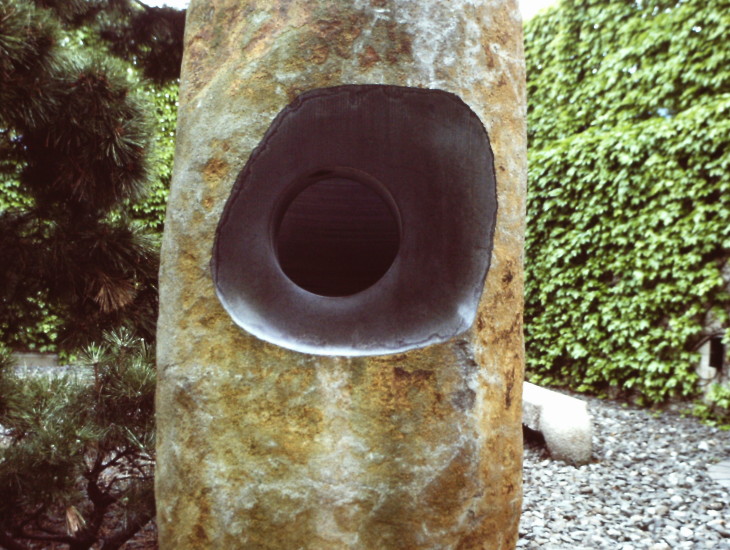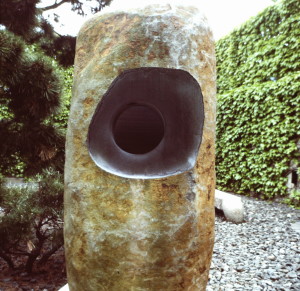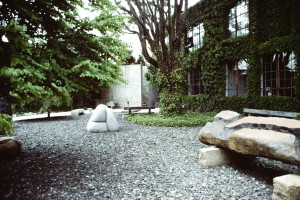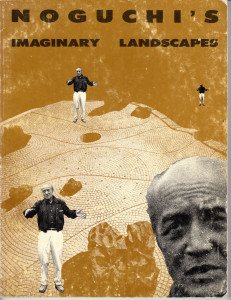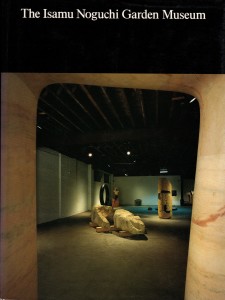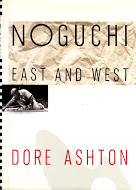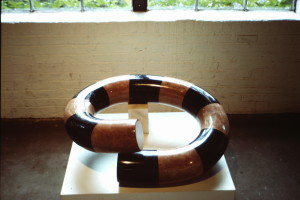Why Noguchi?
Isamu Noguchi’s landscape works, imaginary and realized, offer great lessons for contemporary landscape architecture. The work of Noguchi offers an approach that highlights art and meaning as the primary generators of landscape form. This is done without disregarding the importance of environmental factors. While there can be fair criticism concerning some of Noguchi’s earlier site-oriented works, his body of work indicates a steep learning curve relative to his philosophy of sculptural space. The following quote from Noguchi’s autobiography, Isamu Noguchi: A Sculptor’s World, indicates a philosophy that explains his passion to bring sculpture into the expanded environment of the landscape:
“Most sculpture, unfortunately, lives in its own space, with a purely fortuitous relation to wherever it is placed. This is different from true architectural space…I myself have tried to get around this difficulty by seeking commissions which are separate but in counterpoint to the architecture, with an equivalent scale and using the creation of space as an extension of sculpture.” ¹
As the quotation indicates, Noguchi was never satisfied with what he believed was “…space as just a receptacle for sculpture.” ² Noguchi grew to believe that sculpture could also be “…a more direct expression of Man’s relation to the earth and his environment.” Noguchi’s death in 1989 cut short a career that provided a brief yet rich window into his potential to create powerful landscapes. His works continue to be a great influence in my design work and I believe his work bears a fresh look by landscape architects.
Discovering Noguchi
I walked into the diverse sculptural world of Noguchi during a major exhibition of his work entitled ‘Noguchi’s Imaginary Landscapes’ at the Detroit Institute of Art.³ The exhibition catalogue provided the initial research I needed to begin my exploration of Noguchi-style. My status as a graduate student in landscape architecture at The University of Michigan in Ann Arbor afforded the time to research Noguchi. The museum exhibit spaces were filled with sculptural forms, designs for the stage, unrealized projects, and realized projects as organizing themes outlined in the catalogue. I had come to graduate school to expand my horizons as a designer, thus, the discovery of Noguchi during the second year of my two-year study was inspiring and changed my view of landscape architecture as an art form. Understanding the sophistication of this exquisite array of sculptural forms in wood, stone and metal – the stone landscape tables; the dance stage sets; and the metal sculptures was a wonderful challenge.
It would take years of experience in public and private practice as well as art and art history study to understand how Noguchi’s work could inform landscape architecture design. After ten years of professional practice in the San Francisco Bay Area, I remained a student of Noguchi but found it difficult to experiment with what I had learned from his work. Ironically, eleven years after leaving The University of Michigan graduate program, I returned as an Assistant Professor in the School of Natural Resources and Environment.
I was thrust into the world of ‘research’ in my first teaching position and again Noguchi came to my rescue. Utilizing the work of Noguchi was an easy fit within my overall design theory research agenda. After several research grants, visits to New York City, and visits to the Noguchi Museum in Queens, my vision was clearer as to the methods of Noguchi-style. I give major credit to a student research assistant, Patricia McGirr, for her insightful reading of Noguchi’s work while expanding upon my initial research leads. 4 The epiphany she brought to light was in her words – “if you make yourself very small and inhabit Noguchi’s sculptures, particularly his landscape table series, you are in a fascinating landscape world.” In fact, I believe that Noguchi was constantly exploring how to expand the world of the individual sculpture as an experiential medium long before his visionary and realized sculptural landscape projects were conceived.
Applying Noguchi
While living in New York for a month as part of a research grant, I was fortunate to meet with Dore Ashton, art historian and author of the Noguchi biography, Noguchi East and West. A powerful and devoted advocate of Noguchi’s work, she sensitively captured Noguchi’s struggles to reconcile his Japanese culture, via a fractured relationship with his Japanese father, and his American culture, via his mother’s white Midwestern heritage. In her books preface Ashton states “…The bamboo is segmented, as was Noguchi’s life, yet it grows tall and, despite its compartmented structure, is a single organism. I think of Noguchi’s life’s work as an organism and have set out to highlight the various experiences, circumstances, and sources that nourished it.” This informative biography led me to explore Noguchi’s autobiography for even more insights into his life, design thinking and ethic. I remain grateful to Dore Ashton for granting me an interview with her in 1992 at her summer home. 5
After the inspiring meeting with Dore Ashton, I searched New York for Noguchi’s autobiography. As luck would have it, I found a copy of the autobiography at a small bookstore on West 18th Street near Fifth Avenue. After reading the autobiography from cover to cover, I knew that I had found the inspiration that would help me answer the central question of my career – “how do you make landscape art?” Noguchi was only the beginning in a series of influences, but his work helped me develop a more expansive design process that I have utilized in practice and teaching and I continue to return to his autobiography for inspiration. There are two major factors that I believe Noguchi utilized to push his idea of ‘architecture space’ that has relevance to contemporary landscape architecture design:
Interpreting and Revealing – The idea that the environmental, cultural, historical and other aspects of a site establish the ground for shaping poetic spatial ideas and landscape forms.
Carving and Shaping – The Noguchi process was most often a ‘subtractive’ design process – the act of carving a spatial volume. Each sculpture and space was viewed first as a solid volume from which an interpreted idea is carved and revealed.
I have found that integrating these two basic design factors into the landscape architecture design process allows for more ‘control’ of design forms. Interpreting the meaning intrinsic to a site allows an informed understanding of ‘why’ and ‘how’ geometric design systems are generated. In the same way, carving in a subtractive manner allows an informed sculptural process to unfold. During my thirteen plus years of teaching at both the undergraduate and graduate levels (landscape architecture and introductory architecture design) as well as twenty plus years of professional practice, I have utilized these two Noguchi inspired design factors with great success. Working with students, in particular, was of great benefit in solidifying a more sculptural design process.
I have to give credit to my former students at various universities for ‘learning with me’ as I developed a more poetic art-based design process. 6 While these explorations have been a personal journey, I believe that the work of Isamu Noguchi offers great lessons for the profession of landscape architecture in education and professional practice. As landscape architects, we speak of the profession as an ‘art and a science.’ The work of Isamu Noguchi is instructive as to the path toward an art-based approach to designing landscapes as well as the integration of science-based issues. I believe that Noguchi deserves a closer look by students, scholars and practitioners as we seek to inform new modes of landscape expression. The time has come for another look at the world of Isamu Noguchi.
Notes
- Quote from Noguchi autobiography, A Sculptor’s World, page 158
- Additional quotes from Noguchi autobiography, page 159
- The Noguchi Imaginary Landscapes exhibit began at the Minneapolis Walker Art Center and moved to Denver, Cleveland, Detroit and San Francisco between the dates of April 23, 1978 – September 2, 1979
- Patricia McGirr, with a background in architecture and landscape architecture, is currently a professor of landscape architecture at University of Massachusetts – Amherst
- My one regret is that I never took Ms. Ashton’s advice to immediately continue my research and write a book that would make connections to landscape architecture and Noguchi’s work.
- Thanks to students, architecture and landscape architecture, at The University of Michigan, City College of New York, Rutgers University, Columbia University, Florida A&M University, and Morgan State University.
- All photo images by Glenn LaRue Smith
References
- Torres, Ana Maria. 2000. “Isamu Noguchi: A Study of Space,” The Monacelli Press, New York.
- Apostolos-Cappadona, Diane and Altshuler, Bruce, eds. 1994. “Isamu Noguchi: Essays and Conversations,” Harry N. Abrams, Inc., New York.
- Karasov, Deborah and Waryan, Steve, eds. 1993. “The Once and Future Park.” Princeton Architectural Press, Inc. New York, New York.
- Ashton, Dore. 1992. “Noguchi East and West,” Alfred A. Knopf, New York.
- Smith, G. L. 1992. “Spatial Poetry and the Noguchi Vision” – “The Isamu Noguchi Garden Museum, Isamu Noguchi” and “Isamu Noguchi: Space of Akari and Stone, Takahiko Okada,” Design Book Review, Issue 24, Spring, pp. 52-55. (Book Review).
- Graham, Martha. 1991. “Blood Memory: An Autobiography,” Doubleday Publishers, New York.
- Smith, G. L. 1991. “The Noguchi Garden as Theater;” The Public Art Review, Issue 6, Vol. 3, No. 2, Fall/Winter , pp.22-23.
- Noguchi, Isamu. 1987. “ The Isamu Noguchi Garden Museum,” Harry N. Abrams, Inc., New York.
- Noguchi, Isamu. 1967. “Isamu Noguchi: A Sculptor’s World,” Thames and Hudson, New York.
- Friedman, Martin. April 1978. “Noguchi’s Imaginary Landscapes,” The Walker Art Center Publication, Minneapolis, MN (exhibition catalogue).
